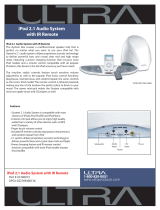PlayingbackmusicviaBluetooth............................... 59
Connecting a Bluetooth receiver .................................................................. 59
Pairing Bluetooth components ................................................................... 59
Establishing a wireless connection and playing back .............................................. 60
Playing back music stored on a USB storage device .............. 61
Connecting a USB storage device ................................................................. 61
Playback of USB storage device contents ......................................................... 61
Playing back music stored on PCs ............................... 64
Media sharing setup ............................................................................. 64
Playback of PC music contents ................................................................... 64
Listening to Internet radio ...................................... 67
Playing back music in multiple rooms (multi-zone) ............... 69
Preparing for Zone2 .............................................................................. 69
Controlling Zone2 ............................................................................... 71
Useful functions ............................................... 72
Registering favorite items (shortcut) .............................................................. 72
Controlling this unit from the web browser (web control) ......................................... 73
Viewing the current status ........................................................................ 75
Configuring settingsin accordancewith a playback source(Option menu) ... 76
Option menu items .............................................................................. 76
Configuring input sources (Input menu) ......................... 79
HDMI ........................................................................................... 95
Network ........................................................................................ 96
Multi Zone ...................................................................................... 97
Function ........................................................................................ 97
Language ....................................................................................... 99
Viewing information about this unit (Information menu) ........ 100
Types of information ........................................................................... 100
Configuring the system settings (ADVANCED SETUP menu) ..... 101
ADVANCED SETUP menu items ................................................................. 102
Changing the speaker impedance setting (SP IMP.) .............................................. 102
Selecting the remote control ID (REMOTE ID) .................................................... 102
Resetting the Parental Lock code number (SR LOCK) ............................................. 102
Switching the video signal type (TV FORMAT) ................................................... 102
Removing the limitation on HDMI video output (MON.CHK) ..................................... 103
Restoring the default settings (INIT) ............................................................. 103
Updating the firmware (UPDATE) ............................................................... 103
Checking the firmware version (VERSION) ....................................................... 103
Controlling external devices with the remote control ........... 104
Setting the remote control code for a TV ........................................................ 104
Setting the remote control codes for playback devices .......................................... 105
Resetting remote control codes ................................................................. 106
Updating the firmware of this unit ............................. 107
Input menu items ................................................................................ 79
Configuring the SCENE function (Scene menu) ................... 82
Scene menu items ............................................................................... 82
Configuring soundprograms/surround decoders (SoundProgram menu) ... 84
Sound Program menu items ...................................................................... 85
Configuring various functions (Setup menu) ..................... 87
Setup menu items ............................................................................... 88
Speaker (Manual Setup) .......................................................................... 90
Sound ........................................................................................... 93
Video ............................................................................................ 94
Frequently asked questions ................................... 108
Troubleshooting .............................................. 109
Power and system .............................................................................. 109
Audio .......................................................................................... 110
Video .......................................................................................... 111
FM/AM radio ................................................................................... 112
USB and network ............................................................................... 112
Remote control ................................................................................ 113
Error indications on the front display .......................... 114
Error indications for SIRIUS Satellite Radio TM . .................................................... 115
E. 3






















